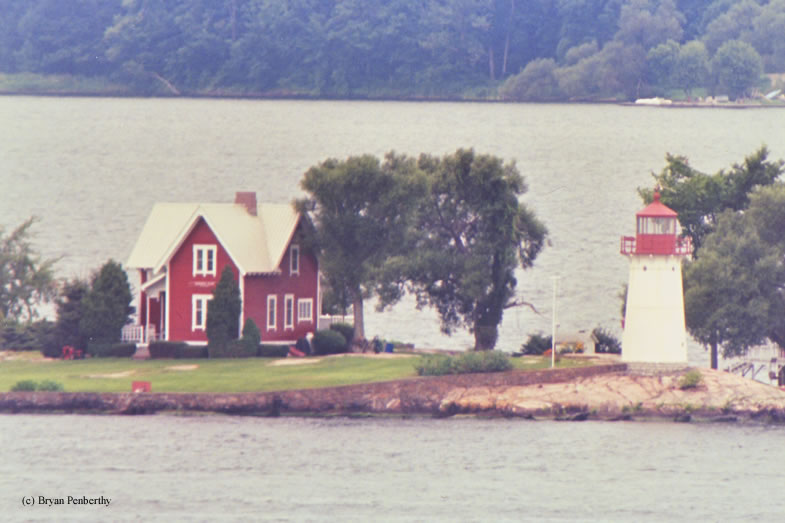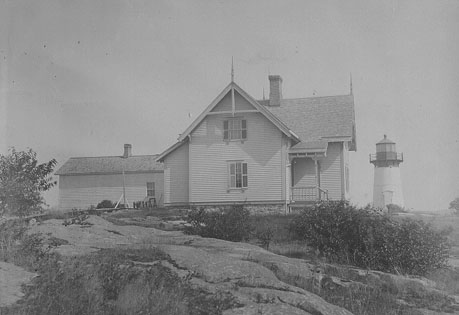Crossover Island Lighthouse
Hammond, New York - 1882 (1848**)

History of the Crossover Island Lighthouse
Posted/Updated by Bryan Penberthy on 2014-08-17.
Vessels have been sailing the St. Lawrence River as early as the mid-1500s. Navigation was difficult at best due to many submerged rocks and shoals. To remedy some shallow sections, several canals were created, including the Lachine Canal in 1825, which helped turn Montreal into a major port, thus increasing vessel traffic on the river.
Other improvements took place near Port Weller, Ontario in 1829 when the Welland Canal was excavated. It linked Lake Ontario to Lake Erie, between Port Colborne and Port Weller. Prior to this, to get cargo between the two lakes, vessels had to be offloaded, travel across a portage road, and then reloaded.
These improvements helped increase vessel traffic along the St. Lawrence River. While navigating the river, the shipping channel would cross over the international boundary between the United States and Canada near a small island, which became known as Crossover Island.
In a report dated November 26, 1838, Lieutenant Charles T. Platt, U.S. Navy, had expressed some thoughts about "increasing the advantage of commerce to the river."
In the story, he repeats the points he had gained in a previous report stating that lighthouses should be constructed at Bartlett Point and Crossover Island. He went into detail on a lighthouse at Crossover Island, which he added in the entry for Tibbetts Point Lighthouse. In the entry, he says:
Still, there are other important points of equal interest to the safety of navigation through this difficult and perilous river. And with this view of the subject, I conceive it my duty to represent, in the strongest terms, the necessity of establishing a beacon-light upon Cross over island, eight miles above Morristown. This island is situated between the two channels, and will be a guide for either. It would be a difficult task to attempt an adequate representation of the numerous shoals and sunken islands obstructing the navigation of this river; generally, however, they are located in the neighborhood of the Thousand islands; and it is in the midway of this cluster of islands, and the only feasible channel, that Cross-over island, on which it is proposed to erect a beacon-light is situated.
Cross-over island is about eight rods in length and five rods wide; is a solid rock, with a few trees, that have taken root through the crevices in the rocks. It is proposed to erect a building for the keeper, and to place the light on top. This may be done, and the building so constructed as to admit of a cellar above ground, by giving the walls a sufficient height to admit of embankments, which, it is presumed, will effectually protect the basement story from frost. This may be done for a trifling expense, compared to the blasting of a cellar from a solid rock. I therefore respectfully submit the following estimate and dimensions:
The dwelling to be 25 by 30 feet; the basement to be 5-1/2 feet in height and 2-1/2 thick; after which, the walls will be continued at a thickness 2 feet for 12 feet in height, to the eaves; extreme height 29-1/2 feet, including the basement, partitioned on the first floor, (above the basement,) with an entry in the centre 5 feet in width; leaving one room, kitchen, bed-room, and pantry, and on the second floor, 2 arched bed-rooms.
Lieutenant Platt estimated that the station cost would be just over $2,000. It would require some time, however, Congress would set aside the necessary funds on March 3, 1847 for three lighthouses along the St. Lawrence River.
The three lighthouses funded were Rock Island, just offshore from Fishers Landing, Sunken Rock near Alexandria Bay, and the Crossover Island Lighthouse, all in the Thousand Islands region of New York. The government purchased the three islands from Chesterfield and Mary Ann Pearsons and Azariah, and Mary Walton for $250.
This lighthouse was a most likely an exact replica of the Rock Island Lighthouse, which was completed one year earlier in 1847. Constructed was a one-and-one-half-story brick dwelling with a wooden tower protruding through the roof at a height of 10 feet.
By 1869, the tower was in poor condition. The Report of the Secretary of the Treasury on the state of Finances for the year 1869 had the following entry detailing the work conducted:
12. Cross-over Island - This station has been put in good condition. Boat-house and ways have been built, woodshed repaired, shutters put on the windows, plastering renewed in both house and tower, and chimney-tops renewed. The isolated position of this station has made repairs more than usually expensive.
The work carried out in 1869 held the station over for a few years, but by 1872, the entry listed in The Report of the Secretary of the Treasury on the State of Finances painted the station in a dim light.
461. Cross-Over Island, River Saint Lawrence, New York - The tower and dwelling are both in very bad condition, and are not worth repair. The tower is of wood, and rises from the roof of the brick dwelling; the timber is so decayed, and the interior framing so badly arranged, that water finds its way into the interior at all points of the connection with the roof. The brick of which the old dwelling is built were originally very inferior, and have been so injured by frosts, that the walls are now unserviceable, and cannot be used for supporting any new work. They were sheathed on the outside with boards, in 1869, but this was a temporary expedient, serving only to relieve the cold and dampness of the dwelling, until the whole could be renewed. An appropriation of $11,000 is required for a new tower and dwelling.
Over the years, various repairs were carried out. By 1879, a recommendation for a detached tower and a $5,000 appropriation to pay for it was made. The following year, the Lighthouse Board again recommended that the entire station be rebuilt:
540. Cross-over Island, Saint Lawrence River, New York - Some slight repairs were made to this station, but it should be rebuilt. A tower should be erected apart from the keeper's dwelling and the latter thoroughly renovated. The estimated cost of these repairs and a new tower is $5,000.
Changes finally came in 1882. Constructed was a new six-room, two-story keeper's dwelling, very similar in style to those erected at Tibbett's Point in New York and Marblehead in Ohio. The dwelling had three gables, which were adorned with heavy cross-timbers and decorative finials.
Rather than a lighthouse affixed to the roof of the dwelling, a separate cast-iron lighthouse was erected on a concrete pad placed upon a smooth section of rock on the island. Inside the tower, up to the first landing, a brick lining was installed utilizing the bricks from the old dwelling. Above that, the tower was lined with wood.
 Crossover Island Lighthouse (Courtesy Coast Guard)
Crossover Island Lighthouse (Courtesy Coast Guard)
The power of the lighthouse was reduced at that time as well. Originally, a fourth-order Fresnel lens was in use in the old tower. However, the new cast-iron tower received a smaller sixth-order lens, which was removed from the Presque Isle Outer Pierhead Lighthouse. The Presque Isle Outer Pierhead received the larger fourth-order lens in exchange.
The following year, some finishing touches were added to the station, including a porch constructed over the front of the dwelling, a walk leading from the tower to the dwelling, and the old kitchen was moved to the rear of the new dwelling.
As the cistern in the cellar of the keeper's dwelling was unable to meet the demands of the keeper's family, a well was constructed at the station in 1884. Crews were able to dig through granite, and found water at a depth of 25 feet and 7 inches, which, coupled with a deep-well pump, was able to provide an adequate supply of fresh water.
A gale which occurred on January 13, 1890, destroyed the keeper's barn, which he was able to rebuild that year. Upgrades to the station came in 1896 with a new 70-barrel cistern taking the place of the aging brick one in the dwelling's cellar. A new ice house and boat way were also constructed that year.
The lighthouse was originally painted brown when it was established in 1882. However, to increase its effectiveness as a daymark, it was painted white at the opening of the 1899 shipping season.
The following year, to level the island, 300 cubic yards of dirt were brought to the island to fill in the depressions. In 1903, to provide an area for the keeper to grow crops, a seawall was installed. That same year, an iron oil house was erected. The following entry was placed in the Annual Report of the Lighthouse Board that year:
44. Cross-Over Island, St. Lawrence River, New York - A masonry wall 232 feet long was laid up in Portland cement, partly around the island, to increase and protect the arable area. About 35 cords of good soil have been filled in behind this wall for grading purposes. Various repairs were made.
Within two years, the seawall was leaking, which required removing the dirt behind it to patch the leaks.
The lighthouse was in use until April 10, 1941, when the St. Lawrence Seaway opened, bringing with it more modern navigational markers. The property sat vacant until 1960, when it was sold as a private residence. The island was sold again in 1969 to Maynard and Betty Jo Dutcher, a couple that had occasionally picnicked on the island.
The island stayed in the Dutcher Family until 2002, when it was sold to John Urtis for $465,000. John, a pilot and professional photographer was actually looking for a farm when he ran across the lighthouse.
After owning the lighthouse for several years, John Urtis placed it on the market in 2011 for $539,000. Public records show that it on November 11, 2013 for $350,000.
The Crossover Island Lighthouse was added as to the National Register of Historic Places in 2007. This designation will allow it to qualify for preservation programs, matching state grants, and federal historic rehabilitation tax credits.
The Lighthouse is private property. Please DO NOT trespass.
Reference:
- Annual Report of the Light House Board, U.S. Lighthouse Service, Various years.
- Various Government Documents, Federal & State Governments, Various dates.
- The Rock Island Lighthouse Historical & Memorial Association website.
- "Newly renovated Rock Island Lighthouse reopens to visitors," Jaegun Lee, Watertown Daily Times, June 6, 2013.
- Seaway Trail Lighthouses: An Illustrated Guide to 27 Historic Lights Along New York State's Great Lakes, Niagara & St. Lawrence Rivers, & Pennsylvania's Lake Erie Shoreline, James Tinney,Mary Burdette-Watkins, November 1, 1997.
Directions: This lighthouse sits off shore in the St. Lawrence River. The best view of the lighthouse from shore is along River Edge Road which runs parallel along Route 12 just west of Chippewa Bay. While heading east out of Chippewa Bay, make a left onto Conger Road, then bear right onto River Ledge Road. I got my shots from in between the houses along this road. You will want to use a telephoto lens or access a boat to get better shots.
Access: The lighthouse is privately owned. The tower and grounds are closed.
View more Crossover Island Lighthouse picturesTower Height: 30.00'
Focal Plane: Unknown
Active Aid to Navigation: Deactivated (1941)
*Latitude: 44.49700 N
*Longitude: -75.77800 W
See this lighthouse on Google Maps.
